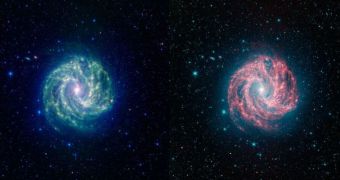Observing the Milky Way from the outside may take a long time to become possible, astronomers say, so this is why they are conducting studies on galaxies that they say may give a clue as to our own's outwardly appearance. The latest such object to be imaged was the Pinwheel Galaxy.
In order to see the object in detail, researchers used the NASA Spitzer Space Telescope, which surveys the sky in infrared wavelengths. The images were collected in two different portions of the electromagnetic spectrum, so that they could later be combined with other datasets.
Messier 83 is known as the Southern Pinwheel Galaxy because it is oftentimes mentioned in the same sentence as the Northern Pinwheel Galaxy, called Messier 101. They are however not at all related.
What makes M83 so interesting to astronomers is that it was classified as being a member of the same class of galaxies that includes the Milky Way – barred spiral galaxies. This designation is given to structures that feature bar-like stellar patterns around their cores.
However, observing these bars in visible-light wavelengths is not nearly as interesting as seeing them in infrared. Spitzer was for example able to see the S-shaped dust curve that winds its way through one of the more linear star bars at the core of M83.
Experts with the NASA Spitzer Science Center (SSC), at the California Institute of Technology (Caltech), in Pasadena, say that stellar nurseries appear as reddish-white dots in this new image. Infrared telescopes are generally used to observe such structures.
Stars are generally born within massive dust and gas clouds, which by their very nature block visible light from exiting the area of intense stellar formation. However, infrared light can easily pierce these natural blocks, and become visible to telescopes even from a great distance.
Spitzer was also able to reveal the existence of tightly-wounds spiral arms in the outer disk of the galaxy. These features are admittedly smaller than main arms of the galaxy. The disk and the core are connected by a rich web of material, which shines brightly in the telescope's detectors.
Though located more than 15 million light-years from Earth, the galaxy is estimated to be among the closest barred spirals to our location. This makes it a prime target for astronomical research. Data collected in these investigations may yield more insights into how the Milky Way looks like.

 14 DAY TRIAL //
14 DAY TRIAL //